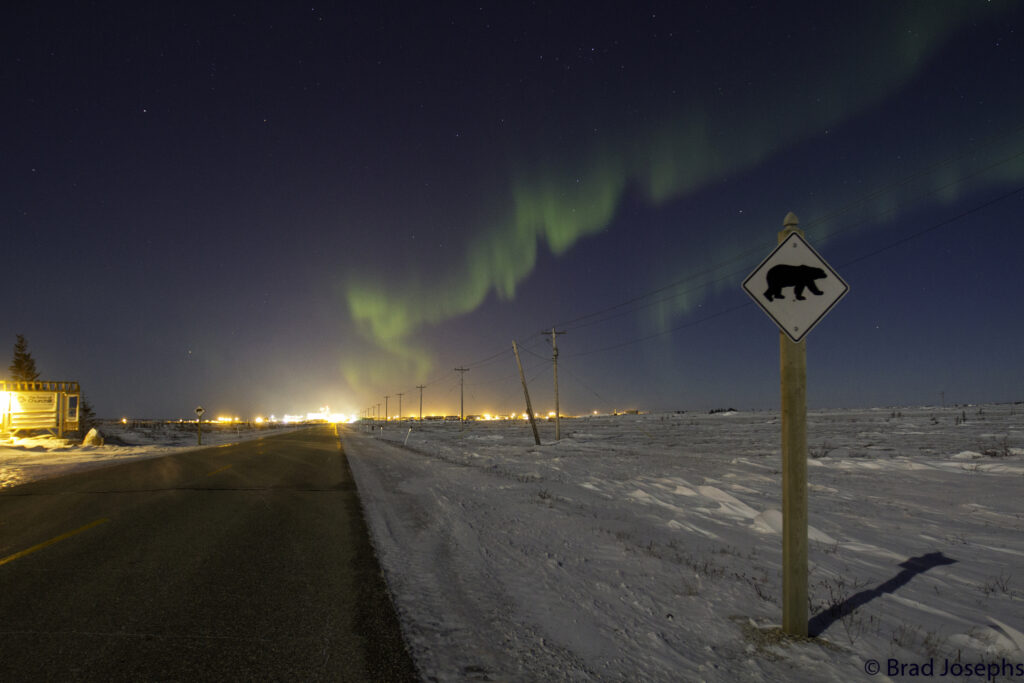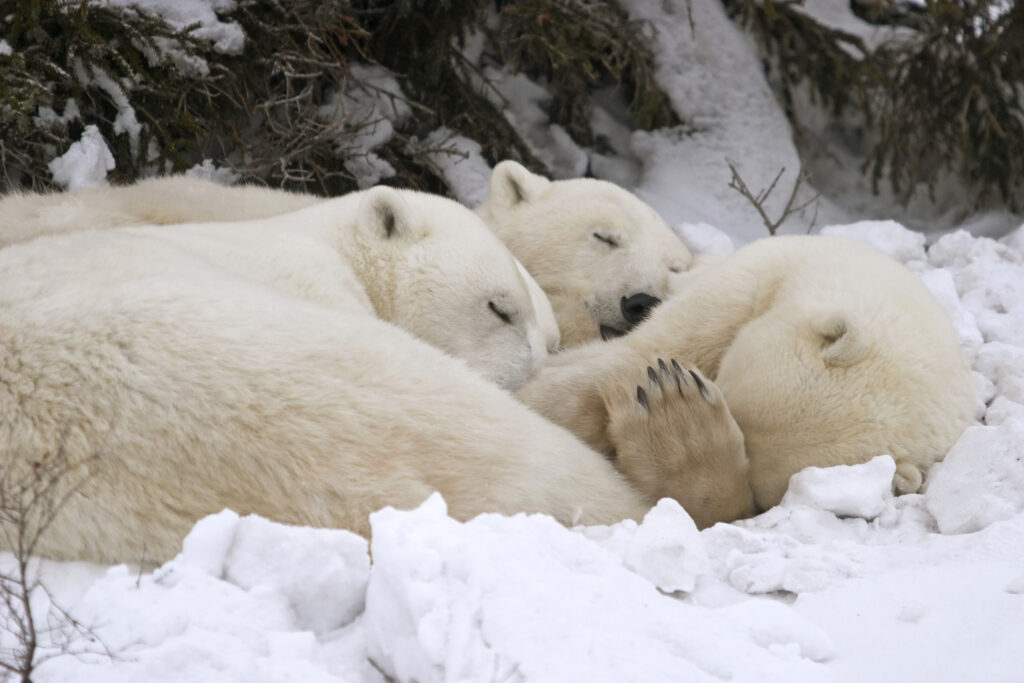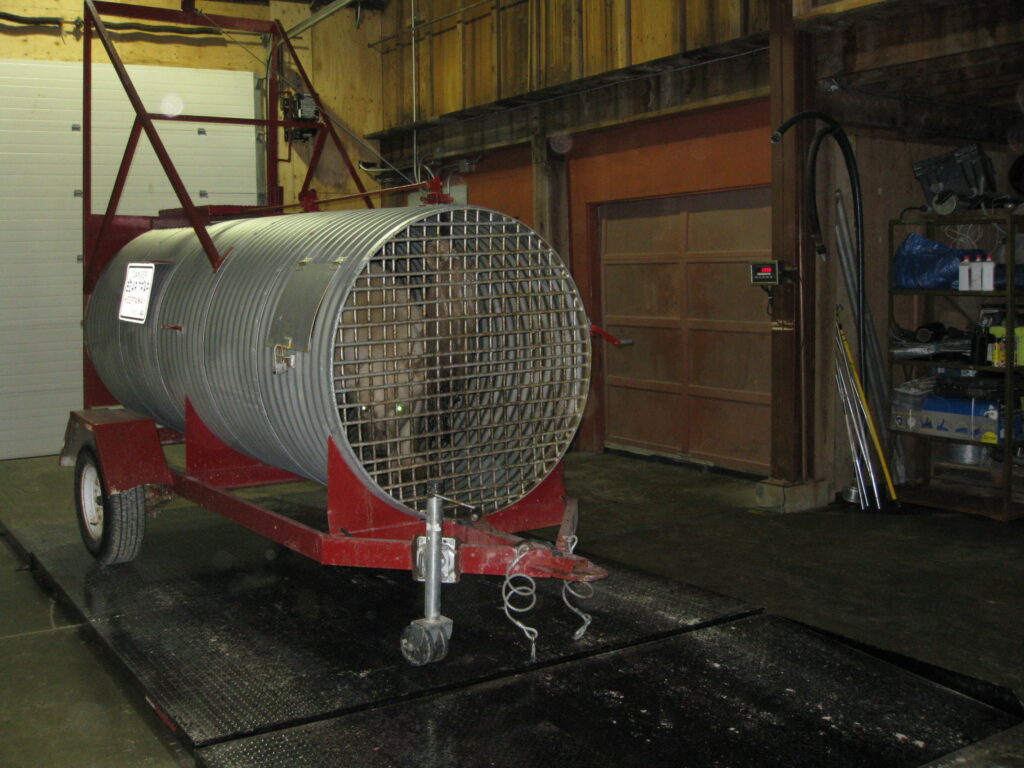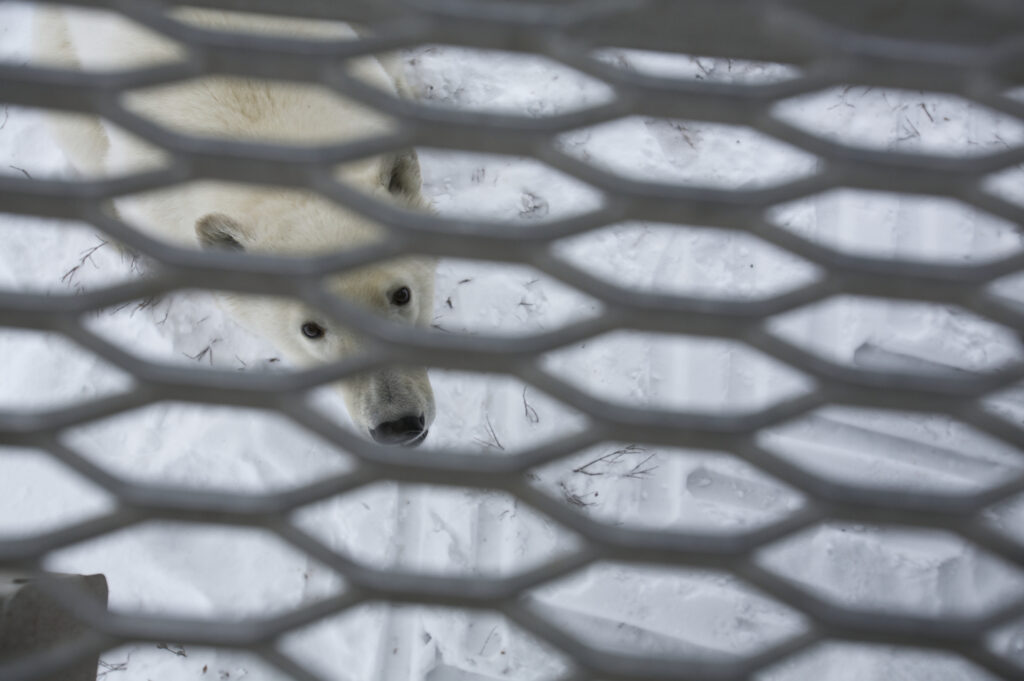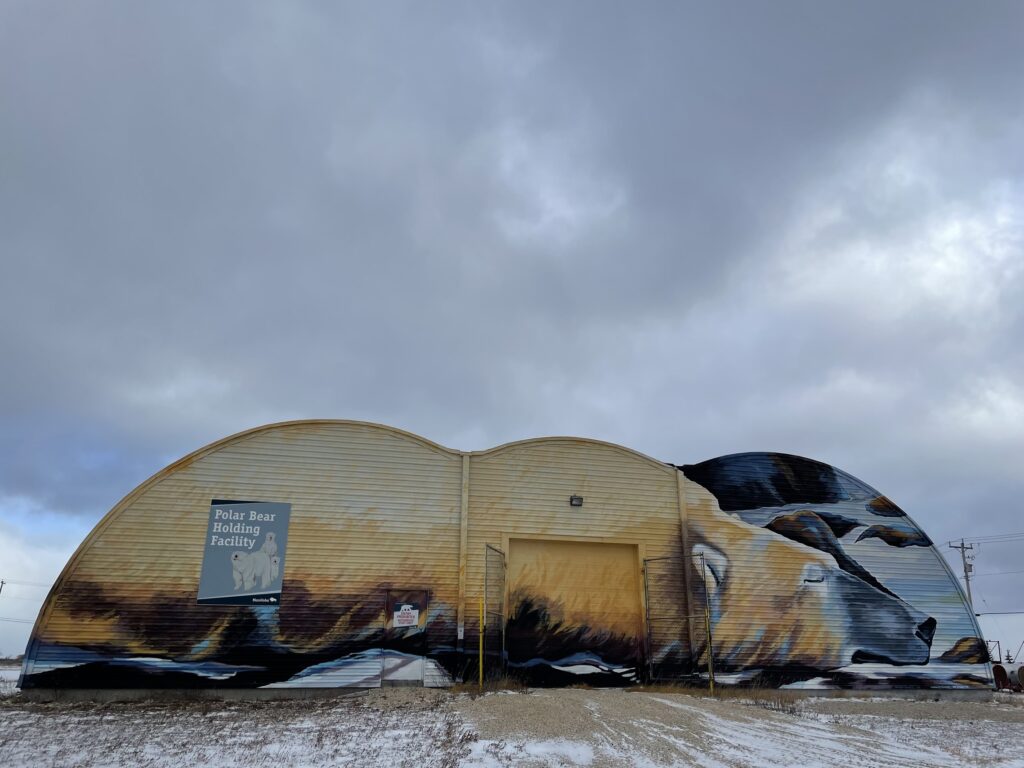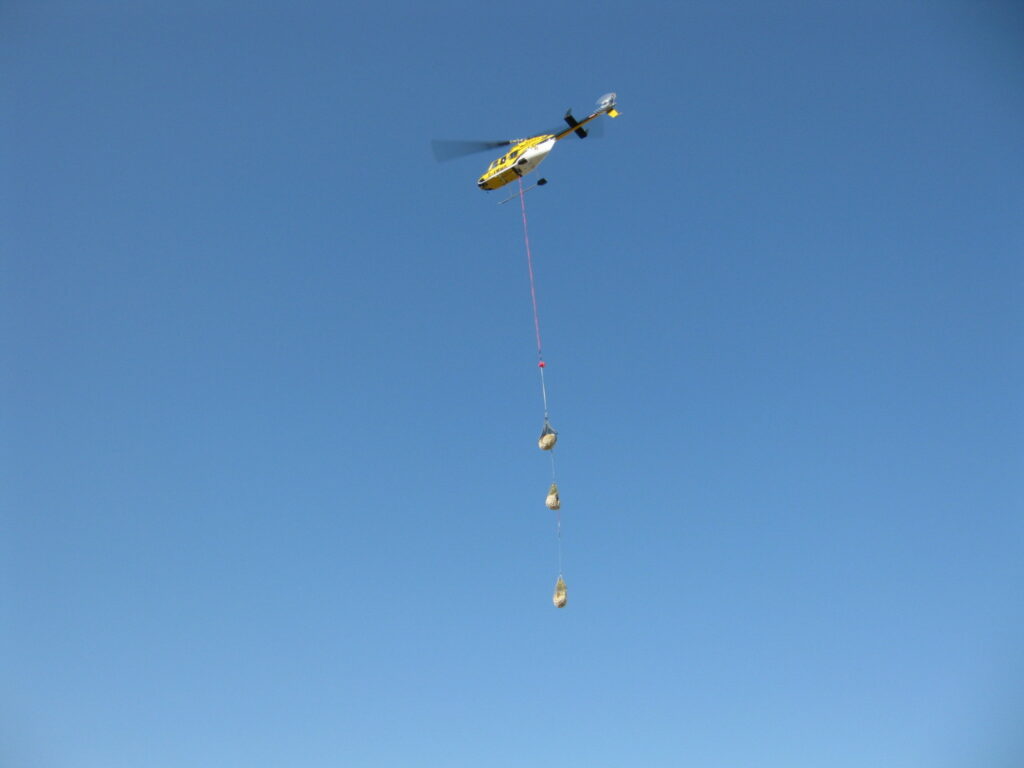In Churchill, Manitoba — with an equal number of people and polar bears — everyone must play by the rules.
“We’ve got a sleeper,” the radio crackles suddenly, and our driver throws our Tundra Rover into gear. That means that the other vehicle, carrying the second half of our group, has spotted a polar bear sleeping in the bushes. By the time we arrive, the bear is walking towards us, checking us out. When it reaches our Rover, it stands up on its hind legs, trying to get a closer look at us, its huge paws touching the back ramp. It’s so close we can see its eyes — shimmering black against its ivory fur. Thankfully, we can do so safely from the elevated platform of our Tundra Rover — a vehicle with six-foot-tall wheels, designed to allow passengers to see the Kings of the Arctic out in the wild near Churchill, in Manitoba, Canada. “It’s a male,” says our guide Rachel Sullivan-Lord, a marine biologist who leads Natural Habitat Adventures tours, who can tell the gender by the shape of the bear’s head. “And of course, it is hungry, just like every other polar bear here right now.”
Coexisting with bears requires following specific rules and having specific skills. Churchill children memorize the Polar Bear Alert Hotline number before they memorize their birthday dates.
About 850 bears — as many as there are people in Churchill — congregate in the area in October and November. Bears meander, roll on the ground, and sometimes even play-fight in the snow. They’re here in such numbers because they’re waiting for the Hudson Bay to freeze, at which point they can move onto the ice and start hunting seals, their favorite prey. The ice usually melts around July, so the bears haven’t eaten much since then, and they are starving. Churchill sits right in the midst of their annual migration path to the ocean — and that’s a problem. Famished bears regularly wander into town, looking for food and endangering humans and themselves. We are thrilled when these majestic creatures circle our Tundra Rover, but Churchillians have to live with them on a daily basis. “In other places, people may look out the window and see a whitetail deer; here, when you look out the window, you may see an 800-pound apex predator walking down the street,” says Chantal Cadger Maclean, an officer at the Polar Bear Alert Program, whose team patrols every street in Churchill and hazes trespassing bears out of town with firecrackers and loud noises. “People here are the masters of coexistence,” Maclean says.
Coexisting with bears requires following specific rules and having specific skills. Churchill children memorize the Polar Bear Alert Hotline number before they memorize their birthday dates. If you hear a firecracker, you get inside of something instantly — a car, a house, a store. Some Churchill safety concepts can sound counterintuitive to the rest of us. For example, most doors in town, whether on vehicles or homes, stay unlocked so that anyone, be it a neighbor or a by-passer, can hop in when necessary, Maclean says. “If you see a bear, you get inside and call the Polar Bear Alert Hotline.” Her team arrives in under three minutes.
When we head into town towards the end of the day, we, too, learn some important rules: never walk alone in the dark; never wander too far from your group even in daylight — that means no more than a few steps; never venture out of a building or a vehicle without checking for paw prints on the snow; and never leave any food out anywhere. Once a bear finds food within the town’s borders, it will get what Maclean calls “food conditioning.” From that point, it will associate the town with food and keep coming back.

It's not the bears’ fault. “They’re just doing what they are supposed to be doing — making a living,” Maclean explains. They’re waiting for the bay to freeze. Moreover, the warming temperatures are causing ice to melt earlier and freeze later, which means that the bears are staying hungry longer, so of course they are searching for food in a town that’s smack in the middle of their migration route. Today no one would ever build a town here, Maclean says.
Warming temperatures are causing ice to melt earlier and freeze later, which means that the bears are staying hungry longer, so of course they are searching for food in a town that’s smack in the middle of their migration route. Today no one would ever build a town here, says Chantal Cadger Maclean, an officer at the Polar Bear Alert Program.
When Europeans built the first Churchill settlement in the late 1600s, it was a fur trade outpost. In those times, any bear that got within shooting range of humans would likely become that very fur. During the Second World War, Churchill was a northern supply center and military base. Later, in the Cold War era, the U.S. and Canadian military used the base as a research station and rocket launching site. During that time, there existed a Polar Bear Control Program, which meant that when bears got too close to humans, they were euthanized. Around the 1970s, as global attitudes towards wildlife began to change, Churchill's human-bear relationship changed too. Moreover, the military helped.
When the army pulled out of Churchill towards the end of the 20th century, it left behind a “parting gift”: a massive hanger of twenty-eight cells (built from cinder blocks, with steel bar ceilings and doors) that serves as a polar bear holding facility — what townspeople call “the polar bear jail.” That’s where the “repeat offenders” are brought in, either captured into a baited culvert trap or tranquilized. For a few weeks, a jailed bear lives in solitary confinement inside a small and boring cell. Bears are given water but no food, in hopes that they’ll learn that approaching humans results in a very unpleasant experience. There are two “family units” — slightly bigger cells for holding moms and cubs. At the end, bears are either relocated up north by helicopter or released onto the ice if the bay is frozen. Since they’re naturally fasting during their migration season, not eating doesn’t hurt them anymore than it does in the wild. Most learn their lesson and don’t come back. This strategy allows Churchill to avoid euthanizing the bears.
When the army pulled out of Churchill towards the end of the 20th century, it left behind a massive hanger of 28 cells built from cinder blocks that serves as a polar bear holding facility more commonly known as the polar bear jail. That’s where the “repeat offenders” are brought in. For a few weeks, a jailed bear lives in solitary confinement, given water but no food — to learn that approaching humans results in a very unpleasant experience.
“Having that facility has allowed managers to keep bears in the population that otherwise would have been euthanized without the option of holding on to them until the sea ice was reforming,” says Geoff York, senior director of conservation at Polar Bear International, an organization that’s dedicated to preserving the animals. The jail is unique; there’s no other comparable facility in the world, because only the military could accomplish such a feat, York explains. Reachable only by plane, Churchill is so remote that transporting all the cement and the necessary equipment would have been next to impossible for anyone else. “It would be very expensive just to create and build something of that size and that functionality,” York says.
Having polar bears alive and well attracts tourism. Churchill is a prime spot for watching them, and that’s keeping the town’s economy going. “Nowadays, bears are a source of economic sustenance and employment,” says our other guide, Katrina Rozen. The jail itself is an attraction, too. On our way to town, we make a quick stop to check it out.
Some seasons the jail stays relatively empty. Other years are super busy — and 2023 is one of them. This fall, Maclean’s team apprehended fourteen bears, nine of which have already served their sentence and been released; the other five are still locked up. One “perpetrator team” was a mom and cub who found a pail of grease behind a building and kept coming back. “The mom was extremely smart,” Maclean says. She knew enough to avoid culvert traps, so the team had to immobilize both bears with a dart gun from a helicopter. Another one was a huge, old, 800-pound male who managed to rip out part of the wall of Churchill’s waste-management facility — and got his paws onto a pile of trash. “We were really lucky that the bear was just sitting or lying down eating, close enough to the door that we were able to immobilize it,” Maclean says. “It was so heavy that we had to put it in the bucket of a construction loader, which took it to our polar bear holding facility, and we have that guy with us in there right now.” The mom and the cub had already been transported up north, and the big bear will be released once the ice forms.
Releasing bears onto the ice is easy. Maclean’s crew rolls the culvert trap next to the chamber where the bear is and opens the latches. By then, the bear really doesn’t want to be in the chamber, so it hops into the culvert. The crew drives the culvert to the bay and lets the jailbird (ahem, the jailbear) out. Happy to be on the ice, the bears usually take off right away–and if they hesitate, a couple of firecrackers serve as an impetus. For helicopter releases, bears have to take a longish nap.
We aren’t allowed to go inside the jail, but we can take pictures of its exterior, painted as a sleeping polar bear. On the way to the hotel, we stop by the town’s main street to pick up some souvenirs — and are once again reminded to be vigilant. As we leave one of the stores, the icy arctic wind chills me to the bone. I pick up the pace, rushing back toward the bus — and am quickly summoned back by our guide: “Don’t stray away from the group!” I am not sure I could ever master the human-bear coexistence rules, and I am humbled by how Churchillians excel at it. “It's only fair,” our bus driver tells me as I share my awe of their coexistence mastery. “After all, the bears were here before us.”




